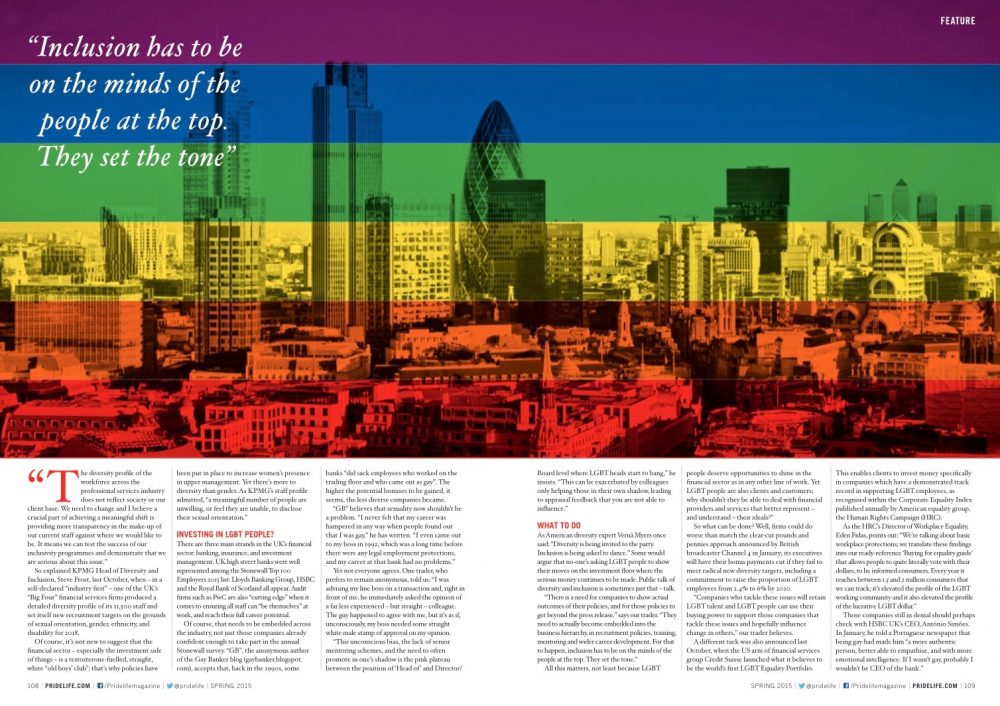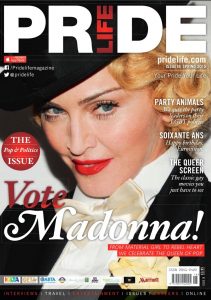
“The diversity profile of the workforce across the professional services industry does not reflect society or our client base. We need to change and I believe a crucial part of achieving a meaningful shift is providing more transparency in the make-up of our current staff against where we would like to be. It means we can test the success of our inclusivity programmes and demonstrate that we are serious about this issue.”
 So explained KMPG Head of Diversity and Inclusion, Steve Frost, last October, when – in a self-declared “industry first” – one of the UK’s “Big Four” financial services firms produced a detailed diversity profile of its 11,500 staff and set itself new recruitment targets on the grounds of sexual orientation, gender, ethnicity, and disability for 2018.
So explained KMPG Head of Diversity and Inclusion, Steve Frost, last October, when – in a self-declared “industry first” – one of the UK’s “Big Four” financial services firms produced a detailed diversity profile of its 11,500 staff and set itself new recruitment targets on the grounds of sexual orientation, gender, ethnicity, and disability for 2018.
Of course, it’s not new to suggest that the financial sector – especially the investment side of things – are a testosterone-fuelled, straight, white “old boys club”; that’s why policies have been put in place to increase women’s presence in upper management. Yet there’s more to diversity than gender. As KMPG’s staff profile admitted, “a meaningful number of people are unwilling, or feel they are unable, to disclose their sexual orientation”.
INVESTING IN LGBT PEOPLE?
There are three main strands in the UK’s financial sector: banking, insurance, and investment management. UK high street banks were well represented among the Stonewall Top 100 Employers 2015 list: Lloyds Banking Group, HSBC and the Royal Bank of Scotland all appear. Audit firms such as PwC are also “cutting edge” when it comes to ensuring all staff can “be themselves” at work, and reach their full career potential.
Of course, that needs to be embedded across the industry, not just those companies already confident enough to take part in the annual Stonewall survey. “GB”, the anonymous author of the Gay Banker blog accepts that, back in the 1990s, some banks “did sack employees who worked on the trading floor and who came out as gay”. The higher the potential bonuses to be gained, it seems, the less diverse companies became.
“GB” believes that sexuality now shouldn’t be a problem. “I never felt that my career was hampered in any way when people found out that I was gay,” he has written. “I even came out to my boss in 1992, which was a long time before there were any legal employment protections, and my career at that bank had no problems.”
Yet not everyone agrees. One trader, who prefers to remain anonymous, told us: “I was advising my line boss on a transaction and, right in front of me, he immediately asked the opinion of a far less experienced – but straight – colleague. The guy happened to agree with me, but it’s as if, unconsciously, my boss needed some straight white male stamp of approval on my opinion.
“This unconcious bias, the lack of senior mentoring schemes, and the need to often promote in ones shadow is the pink plateau between the position of ‘Head of’ and Director/Board level where LGBT heads start to bang,” he insists. “This can be exacerbated by colleagues only helping those in their own shadow, leading to appraisal feedback that you are not able to influence.”
WHAT TO DO
As American diversity expert Vernã Myers once said: “Diversity is being invited to the party. Inclusion is being asked to dance.” Some would argue that no-one’s asking LGBT people to show their moves on the investment floor where the serious money continues to be made. Public talk of diversity and inclusion is sometimes just that – talk.
“There is a need for companies to show actual outcomes of their policies, and for those policies to get beyond the press release,” says our trader. “They need to actually become embedded into the business hierarchy, in recruitment policies, training, mentoring and wider career development. For that to happen, inclusion has to be on the minds of the people at the top. They set the tone.”
All this matters, not least because LGBT people deserve opportunities to shine in the financial sector as in any other line of work. Yet LGBT people are also clients and customers; why shouldn’t they be able to deal with financial providers and services that better represent – and understand – their ideals?”
So what can be done? Well, firms could do worse than match the clear-cut pounds and pennies approach announced by British broadcaster Channel 4 in January; its executives will have their bonus payments cut if they fail to meet radical new diversity targets, including a commitment to raise the proportion of LGBT employees from 2.4% to 6% by 2020.
“Companies who tackle these issues will retain LGBT talent and LGBT people can use their buying power to support those companies that tackle these issues and hopefully influence change in others,” our trader believes.
A different tack was also announced last October, when the US arm of financial services group Credit Suisse launched what it believes to be the world’s first LGBT Equality Portfolio. This enables clients to invest money specifically in companies which have a demonstrated track record in supporting LGBT employees, as recognised within the Corporate Equality Index published annually by American equality group, the Human Rights Campaign (HRC).
As the HRC’s Director of Workplace Equality, Eden Fidas, points out: “We’re talking about basic workplace protections; we translate these findings into our ready-reference ‘Buying for equality guide’ that allows people to quite literally vote with their dollars, to be informed consumers. Every year it reaches between 1.5 and 2 million consumers that we can track; it’s elevated the profile of the LGBT working community and it also elevated the profile of the lucrative LGBT dollar.”
Those companies still in denial should perhaps check with HSBC UK’s CEO, António Simões. In January, he told a Portuguese newspaper that being gay had made him “a more authentic person, better able to empathise, and with more emotional intelligence. If I wasn’t gay, probably I wouldn’t be CEO of the bank.”
Co-written with Daniel Clayton BAcc CA.
Full article published in Spring 2015 (#18) print edition of Pride Life.